Por favor, use este identificador para citar o enlazar este ítem:
http://www.alice.cnptia.embrapa.br/alice/handle/doc/1045916Registro completo de metadatos
| Campo DC | Valor | Lengua/Idioma |
|---|---|---|
| dc.contributor.author | CHEN, Q. | pt_BR |
| dc.contributor.author | LU, D. | pt_BR |
| dc.contributor.author | KELLER, M. | pt_BR |
| dc.contributor.author | SANTOS, M. N. DOS | pt_BR |
| dc.contributor.author | BOLFE, E. L. | pt_BR |
| dc.contributor.author | FENG, Y. | pt_BR |
| dc.contributor.author | WANG, C. | pt_BR |
| dc.date.accessioned | 2016-05-31T11:11:11Z | pt_BR |
| dc.date.available | 2016-05-31T11:11:11Z | pt_BR |
| dc.date.created | 2016-05-31 | pt_BR |
| dc.date.issued | 2015 | pt_BR |
| dc.identifier.citation | Remote Sensing, v. 8, n. 1, p. 1-17, 2015. | pt_BR |
| dc.identifier.uri | http://www.alice.cnptia.embrapa.br/alice/handle/doc/1045916 | pt_BR |
| dc.description | Agroforestry has large potential for carbon (C) sequestration while providing many economical, social, and ecological benefits via its diversified products. Airborne lidar is considered as the most accurate technology for mapping aboveground biomass (AGB) over landscape levels. However, little research in the past has been done to study AGB of agroforestry systems using airborne lidar data. Focusing on an agroforestry system in the Brazilian Amazon, this study first predicted plot-level AGB using fixed-effects regression models that assumed the regression coefficients to be constants. The model prediction errors were then analyzed from the perspectives of tree DBH (diameter at breast height)?height relationships and plot-level wood density, which suggested the need for stratifying agroforestry fields to improve plot-level AGB modeling. We separated teak plantations from other agroforestry types and predicted AGB using mixed-effects models that can incorporate the variation of AGB-height relationship across agroforestry types. We found that, at the plot scale, mixed-effects models led to better model prediction performance (based on leave-one-out cross-validation) than the fixed-effects models, with the coefficient of determination (R2) increasing from 0.38 to 0.64. At the landscape level, the difference between AGB densities from the two types of models was ~10% on average and up to ~30% at the pixel level. This study suggested the importance of stratification based on tree AGB allometry and the utility of mixed-effects models in modeling and mapping AGB of agroforestry systems. | pt_BR |
| dc.language.iso | por | pt_BR |
| dc.rights | openAccess | pt_BR |
| dc.subject | Mixed-effects models | pt_BR |
| dc.title | Modeling and Mapping Agroforestry Aboveground Biomass in the Brazilian Amazon Using Airborne Lidar Data. | pt_BR |
| dc.type | Artigo de periódico | pt_BR |
| dc.date.updated | 2016-05-31T11:11:11Z | pt_BR |
| dc.subject.nalthesaurus | Agroforestry | pt_BR |
| dc.subject.nalthesaurus | Aboveground biomass | pt_BR |
| dc.subject.nalthesaurus | Lidar | pt_BR |
| dc.subject.nalthesaurus | Allometry | pt_BR |
| dc.subject.nalthesaurus | Wood density | pt_BR |
| riaa.ainfo.id | 1045916 | pt_BR |
| riaa.ainfo.lastupdate | 2016-05-31 | pt_BR |
| dc.identifier.doi | 10.3390/rs8010021 | pt_BR |
| dc.contributor.institution | QI CHEN, Zhejiang A&F University; DENGSHENG LU, Michigan State University; MICHAEL KELLER, USDA Forest Service/ Pesquisador Visitante CNPM; MAIZA NARA DOS SANTOS, BOLSISTA CNPM; EDSON LUIS BOLFE, CNPM; YUNYUN FENG, Zhejiang A&F University; CHANGWEI WANG, University of Hawaii at Manoa. | pt_BR |
| Aparece en las colecciones: | Artigo em periódico indexado (CNPM)  | |
Ficheros en este ítem:
| Fichero | Descripción | Tamaño | Formato | |
|---|---|---|---|---|
| 4726.pdf | 6,74 MB | Adobe PDF |  Visualizar/Abrir |









